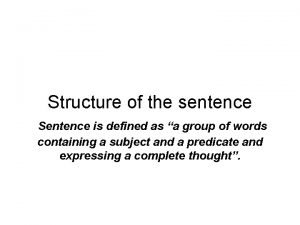IN THE NAME OF ALLAH ALMIGHTY THE MOST





























- Slides: 29

IN THE NAME OF ALLAH ALMIGHTY, THE MOST MERCIFUL, THE MOST BENEVOLENT, THE CREATOR OF ALL THE WORLDS THE PRESERVER SWEDISH COLLEGE OF ENGINEERING AND TECHNOLOGY 1

PROJECT TITLE Manufacturing of Cement SWEDISH COLLEGE OF ENGINEERING AND TECHNOLOGY 2

Submitted To: Engr. Dr. Ayub Elahi Submitted By: MUHAMMAD BIN ANWAR TALHA AKBAR BUTT FARHAN SAJID RANA WASEEM SAEED MUHAMMAD RIZWAN TAHIR SWEDISH COLLEGE OF ENGINEERING AND TECHNOLOGY 42 08 38 01 34 3

INTRODUCTION Definition: “Cement is a crystalline compound of calcium silicates and other calcium compounds having hydraulic properties” (Macfadyen, 2006). SWEDISH COLLEGE OF ENGINEERING AND TECHNOLOGY 4

Manufacture of Portland cement v Cement is made primarily from a calcareous material, such as limestone or chalk, and from alumina and silica found as clay or shale. Marl, a mixture of calcareous and argillaceous materials, is also used. v The process of manufacturing of cement consists essentially of grinding the raw materials, mixing them intimately in certain propositions and burning in a large rotary kiln at a temperature of up to about 1450 0 C when the material sinters and partially fuses into the balls known as clinker. The clinker is cooled and ground to a fine powder, with some gypsum added, and the resulting product is the commercial Portland cement so widely used throughout the world. v The mixing and grinding of the raw materials can be done either in water or in a dry condition; hence the name ‘wet’ and ‘dry’ processes. The actual methods of manufacture of cement depend also on the hardness of materials used and on their moisture content. SWEDISH COLLEGE OF ENGINEERING AND TECHNOLOGY 5

Manufacture of Portland cement Raw materials Preparation of materials Burning Final processing Quality control SWEDISH COLLEGE OF ENGINEERING AND TECHNOLOGY 6

RAW MATERIALS The fundamental chemical compounds to produce cement clinker are: Lime (Ca. O) Silica (Si. O 2) Alumina (Al 2 O 3) Iron Oxide (Fe 2 O 3) Raw materials used in the production of clinker cement Fly ash: by-product of burning finely grounded coal either for industrial application or in the production of electricity SWEDISH COLLEGE OF ENGINEERING AND TECHNOLOGY 7

Raw materials Limestone (calcium carbonate) is a common source of calcium oxide. Iron-bearing aluminosilicates are the most common source of silica. Aluminum and iron oxides act as fluxing agents i. e. lower fusion temperature of part of the raw mix to a practical firing temperature SWEDISH COLLEGE OF ENGINEERING AND TECHNOLOGY 8

Preparation of Materials Crush the materials and store them Blend the materials and grind them Store them and do final blending Blending – assure constant composition and predictable properties. Wet, dry, processes. Burn the materials Grind, blend, and store the materials SWEDISH COLLEGE OF ENGINEERING AND TECHNOLOGY 9

WET PROCESS When chalk is used, it is finely broken up and dispersed in water in a wash mill; this is a circular pit with revolving radial arms carrying rakes which break up the lumps of solid matter. The clay is also broken up and mixed with water, usually in a similar wash mill. The two mixtures are now pumped so as to mix in predetermined proportions and pass through a series of screens. The resulting cement slurry flows into storage tanks. When limestone is used, it has to be blasted, then crushed, usually in two progressively smaller crushers, and then fed into a ball mill with the clay dispersed in water. There the comminution of the limestone (to the fineness of flour) is completed, and the resultant slurry is pumped into storage tanks. SWEDISH COLLEGE OF ENGINEERING AND TECHNOLOGY 10

Raw materials are homogenized by crushing, grinding and blending so that approximately 80% of the raw material pass a No. 200 sieve. The mix will be turned into form of slurry by adding 30 - 40% of water. It is then heated to about 2750 0 F(1510ºC) in horizontal revolving kilns (76 -153 m) length and 3. 6 -4. 8 m in diameter. The slurry, in its movement down the kiln, encounters a progressively higher temperature. At first the water is driven off and CO 2 is liberated; further on, the dry material undergoes a series of chemical reactions until finally, in the hottest part of the kiln, some 20 to 30 percent of the material becomes liquid, and lime, silica and alumina recombine. The mass then fuses into balls, 3 to 25 mm (1/8 to 1 in. ) in diameter, known as clinker. The clinker is then cooled and stored, after that its finish grinding 11

CEMENT CLINKERS SWEDISH COLLEGE OF ENGINEERING AND TECHNOLOGY 12

Natural gas, petroluem or coal are used for burning. High fuel requirement may make it uneconomical compared to dry process. Wet process is obsolete. SWEDISH COLLEGE OF ENGINEERING AND TECHNOLOGY 13

DRY PROCESS ü Raw materials are homogenized by crushing, grinding and blending so that approximately 80% of the raw material pass a No. 200 sieve. ü The raw materials are crushed and fed in the correct proportions into a grinding mill, where they are dried and reduced in size to a fine powder. The dry powder called the ‘raw meal’ is then pumped to a blending silo, and final adjustment is now made in the proportions of the materials required for the manufacture of cement. ü In the dry process, the raw meal, which has a moisture content of about 0. 2 percent, is passed through a pre-heater, usually of a suspension type; that means that the raw meal particles are suspended in the rising gases. Here, the raw meal is heated to about 800 0 C before fed into the kiln. üMixture is fed into kiln & burned in a dry state. SWEDISH COLLEGE OF ENGINEERING AND TECHNOLOGY 14

ü This process provides considerable savings in fuel consumption and water usage but the process is dustier compared to wet process that is more efficient than grinding. ü It is then heated to about 2750ºF (1510ºC) in horizontal revolving kilns (76 -153 m length and 3. 6 -4. 8 m in diameter. ü In the kiln, water from the raw material is driven off and limestone is decomposed into lime and Carbon Dioxide. limestone lime + Carbon Dioxide ü In the burning zone, portion of the kiln, silica and alumina from the clay undergo solid state chemical reaction with lime to produce calcium aluminate. silica & alumina + lime calcium aluminate SWEDISH COLLEGE OF ENGINEERING AND TECHNOLOGY 15

Burning process Sintering (become a coherent mass with no melting) Fusion (complete melting) Clinkering – only about ¼ of the charge is in the liquid state Kiln Long steel cylinder pipe Lined with refractory brick Inclined a few degrees Rotated at 60 to 200 rev/h Typically 6 m (20 ft) in diameter and 180 m (600 ft) long Time in the kiln from 2 h (wet process) to 1 h (dry process) or even (20 min) modern heat exchangers Four processes take place in the kiln Evaporation 240 to 450 °C SWEDISH COLLEGE OF ENGINEERING AND TECHNOLOGY 16

ØCalcination 600 to 1100 °C Clay decomposes (600 °C) Limestone decomposes (700 °C) – CO 2 driven off Formation of initial compounds (1000 °C) Initial formation of C 2 S (1200 °C), formation of calcium aluminates and Ferrites Formation of melt (flux compounds melt) (1350 °C) ØClinkering – charge temperature is 1400 to 1600 °C Formation of C 3 S ØCooling Rate of cooling significantly affects the reactivity of the final cement. Clinkers should be cooled quickly to get high quality cement. Ø Clinkers SWEDISH COLLEGE OF ENGINEERING AND TECHNOLOGY 17

ü The rotation and shape of kiln allow the blend to flow down the kiln, submitting it to gradually increasing temperature. ü As the material moves through hotter regions in the kiln, calcium silicates are formed. ü These products, that are black or greenish black in color are in the form of small pellets, called cement clinkers. ü Cement clinkers are hard, irregular and ball shaped particles about 18 mm in diameter. ü On exit from kiln, regardless of the type of process, the clinker is cooled, the heat being used to preheat the combustion air. SWEDISH COLLEGE OF ENGINEERING AND TECHNOLOGY 18

ü The cool clinker, which is characteristically black, glistering, and hard, is interground with gypsum in order to prevent fresh setting of cement. ü The grinding is done in ball mill consisting of several compartments with progressively smaller steel balls, sometimes preceded by passing through a roll press. ü In most plants a closed-circuit grinding system is used; the cement discharged by the mill is passed through a separator, fine particles being moved to the storage silo by an air current, while the coarser particles are passed through the mill once again. ü The performance of a ball mill can be improved by pre-grinding the clinker in a horizontal impact crusher. SWEDISH COLLEGE OF ENGINEERING AND TECHNOLOGY 19

ü The cement clinkers are cooled to about 150ºF (51ºC) and stored in clinker silos. ü When needed, clinker are mixed with 2 -5% gypsum to retard the setting time of cement when it is mixed with water. ü Then, it is grounded to a fine powder and then the cement is stored in storage bins or cement silos or bagged. ü Once the cement has been satisfactorily ground, when it have as many as 1. 1 × 1012 particles per kg (5 × 1011 per lb), it is ready for transport in bulk. SWEDISH COLLEGE OF ENGINEERING AND TECHNOLOGY 20

ü Less commonly, the cement is packed in bags or drums. ü However, some types of cement, such as white, hydrophobic, expansive, regulated-set, oil-well, and high alumina, are always packed in bags or drums. ü A standard bag in the United Kingdom contains 50 kg (110 lb) of cement; a US sack weighs 94 lb (42. 6 kg); other bag sizes are also used. Bags of 25 kg are becoming popular. ü Cement bags should be stored on pallets in a dry place. SWEDISH COLLEGE OF ENGINEERING AND TECHNOLOGY 21

COMPARISON OF WET AND DRY PROCESS v Except when the raw materials necessitate the use of the wet process, the dry process is used now a days in order to minimize the energy required for burning. v Typically, the burning process represents 40 to 60 percent of the production cost, while the extraction of the raw materials for the manufacture of cement represents only 10 percent of the total cost of cement. SWEDISH COLLEGE OF ENGINEERING AND TECHNOLOGY 22

KILN 23

Oxides composition of cement SWEDISH COLLEGE OF ENGINEERING AND TECHNOLOGY 24

CEMENT SILOS 25

THE CEMENT MANUFACTURING PROCESS quarry dumper loader Quarry face 1. BLASTING 2. TRANSPORT storage at the plant crushing conveyor 3. CRUSHING & TRANSPORTATION 1. BLASTING : The raw materials that are used to manufacture cement (mainly limestone and clay) are blasted from the quarry. 2. TRANSPORT : The raw materials are loaded into a dumper. 3. CRUSHING AND TRANSPORTATION : The raw materials, after crushing, are transported to the plant by conveyor. The plant stores the materials before they are homogenized. 26

THE CEMENT MANUFACTURING PROCESS Raw grinding and burning storage at the plant Raw mill conveyor Raw mix 1. RAW GRINDING preheating kiln cooling clinker 2. BURNING 1. RAW GRINDING : The raw materials are very finely ground in order to produce the raw mix. 2. BURNING : The raw mix is preheated before it goes into the kiln, which is heated by a flame that can be as hot as 2000 °C. The raw mix burns at 1500 °C producing clinker which, when it leaves the kiln, is rapidly cooled with air fans. So, the raw mix is burnt to produce clinker : the basic material needed to make cement. SWEDISH COLLEGE OF ENGINEERING AND TECHNOLOGY 27

THE CEMENT MANUFACTURING PROCESS Grinding, storage, packing, dispatch Gypsum and the secondary additives are added to the clinker storage Finish grinding 1. GRINDING silos dispatch bags 2. STORAGE, PACKING, DISPATCH 1. GRINDING : The clinker and the gypsum are very finely ground giving a “pure cement”. Other secondary additives and cementitious materials can also be added to make a blended cement. 2. STORAGE, PACKING, DISPATCH : The cement is stored in silos before being dispatched either in bulk or in bags to its final destination. SWEDISH COLLEGE OF ENGINEERING AND TECHNOLOGY 28

ü In addition to the main processes, there also processes of manufacture of cement, of which one, using gypsum instead of lime. ü Gypsum, clay and coke with sand iron oxide are burnt in a rotary kiln, the end products being Portland cement and sulfur dioxide which is further converted into sulfuric acid. ü In areas where only a small production is required or whole investment capital is limited, a vertical kiln of the Gottlieb type can be used. This fires nodules of raw meal and fine coal powder combined, and produces agglomerated clinker which is then broken up. A single kiln, 10 m (33 feet) high, produces up to 300 tonnes of cement a day. ü China uses several thousand of such kilns. SWEDISH COLLEGE OF ENGINEERING AND TECHNOLOGY 29
 Allah the most gracious
Allah the most gracious In the name of almighty allah
In the name of almighty allah The most
The most سsh
سsh Guddi baji
Guddi baji In the name of allah the most gracious the most merciful
In the name of allah the most gracious the most merciful In the name of allah the beneficent the merciful in arabic
In the name of allah the beneficent the merciful in arabic Aqeedah
Aqeedah In the name of allah the beneficent the merciful
In the name of allah the beneficent the merciful Manusia berencana allah yang menentukan
Manusia berencana allah yang menentukan Allah the almighty
Allah the almighty Bismillah images in english
Bismillah images in english In the name of allah the most gracious
In the name of allah the most gracious In the name of god most gracious most merciful
In the name of god most gracious most merciful In the name of god most gracious most merciful
In the name of god most gracious most merciful In the name of god the most gracious the most merciful
In the name of god the most gracious the most merciful Name all the rays
Name all the rays 7 asmaul husna
7 asmaul husna Kedosaan manusia akan mendatangkan
Kedosaan manusia akan mendatangkan Simple sentence
Simple sentence I confess to almighty god prayer
I confess to almighty god prayer Genuflect
Genuflect Holy holy god almighty the great i am
Holy holy god almighty the great i am I confess to almighty god prayer
I confess to almighty god prayer Praise to the lord the almighty
Praise to the lord the almighty Almighty maker
Almighty maker Almighty god creator of all i believe
Almighty god creator of all i believe Article vi of the code of ethics for professional teachers
Article vi of the code of ethics for professional teachers When god almighty came to be one of us
When god almighty came to be one of us Oh lord almighty
Oh lord almighty




















































